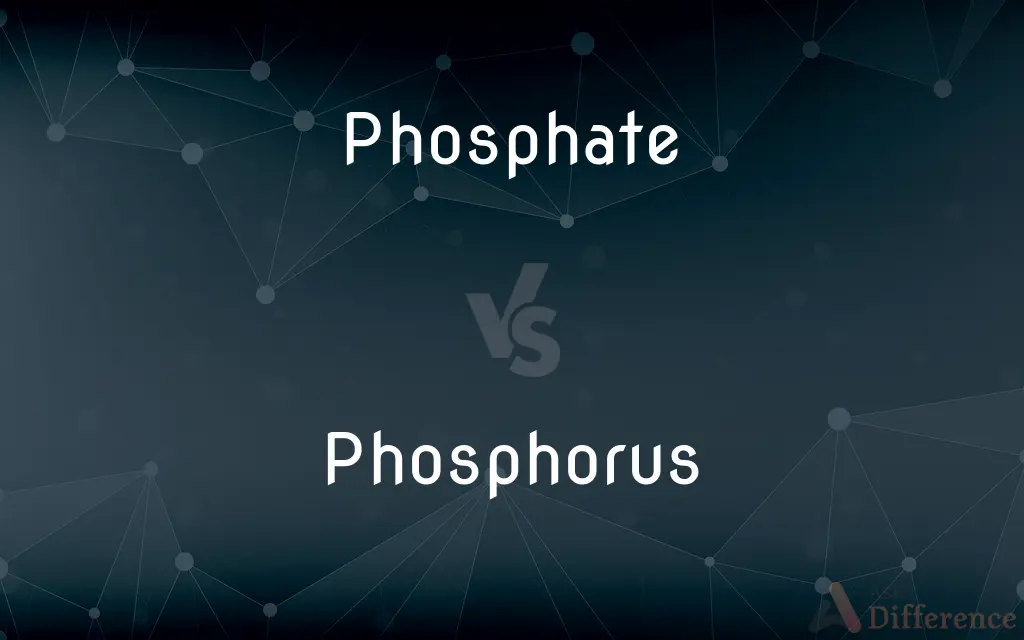Phosphate vs. Phosphorus — What's the Difference?
By Tayyaba Rehman — Updated on October 23, 2023
Phosphorus is a chemical element, while phosphate is a compound containing the phosphorus atom bonded to oxygen atoms.

Difference Between Phosphate and Phosphorus
Table of Contents
ADVERTISEMENT
Key Differences
Phosphate and phosphorus, although closely related in terms of chemistry, serve distinct roles and representations. Phosphorus is a chemical element with the symbol "P" and atomic number 15. It is a non-metal and can be found in nature in several forms, but not as a free element due to its high reactivity. In contrast, phosphate refers to a compound or an ion where the phosphorus atom is bonded to four oxygen atoms, typically represented as PO₄³⁻.
In biological systems, both phosphate and phosphorus play pivotal roles. Phosphorus is essential for life, primarily seen in the form of phosphates. These phosphates are integral to DNA, RNA, ATP, and other fundamental molecules within the body. Therefore, while phosphorus indicates the element in its various forms, phosphate specifically points to the roles and compounds in which phosphorus is bound with oxygen.
The difference between phosphate and phosphorus becomes clearer when discussing nutrient cycles, especially in aquatic ecosystems. Phosphorus, in its elemental form, isn't directly usable by most living organisms. It's the phosphates, the oxygen-bonded forms of phosphorus, that are absorbed and utilized by plants and algae from the water, eventually making their way up the food chain.
In agricultural and gardening contexts, the terms phosphate and phosphorus are frequently encountered. Phosphorus is one of the primary nutrients required for plant growth. However, plants don't absorb elemental phosphorus. They take in phosphates, which are added to soils in the form of phosphate fertilizers. Hence, when referring to soil supplements, it's more accurate to discuss the phosphate content rather than just phosphorus.
Environmental concerns have also brought attention to both phosphate and phosphorus. Excessive phosphate in water bodies, often from agricultural runoff, can lead to eutrophication, where the rapid growth of algae depletes oxygen for other aquatic life. Here, the distinction is crucial. It's the compound phosphate, not elemental phosphorus, causing this over-enrichment.
ADVERTISEMENT
Comparison Chart
Nature
Compound or ion.
Chemical element.
Representation
PO₄³⁻
P with atomic number 15.
Biological Role
Found in DNA, RNA, ATP.
Essential element, mainly seen as phosphates.
Usability by Plants
Directly absorbed from soils.
Not directly usable; plants absorb its phosphate form.
Environmental Concerns
Can lead to eutrophication in water bodies.
Elemental form isn't the cause of eutrophication.
Compare with Definitions
Phosphate
A molecule or ion containing the phosphorus atom bonded to four oxygen atoms.
ATP, an energy currency in cells, has three phosphate groups.
Phosphorus
A chemical element with symbol P and atomic number 15.
Phosphorus is a critical nutrient for plants and animals.
Phosphate
A salt or ester of phosphoric acid.
The soil needs more phosphate to improve crop yield.
Phosphorus
Essential for the formation of DNA, RNA, ATP, and other molecules.
The phosphorus in our bones primarily comes from dietary sources.
Phosphate
The anion, salt, or ester derived from the anhydride of phosphoric acid, PO₄³⁻.
Certain detergents contain high levels of phosphate.
Phosphorus
One of the primary nutrients in fertilizers.
To enhance flowering, plants may need additional phosphorus.
Phosphate
A key component in DNA and RNA molecules.
The backbone of DNA consists of alternating sugar and phosphate molecules.
Phosphorus
A non-metal that exists in several allotropic forms.
Red and white are two common allotropes of phosphorus.
Phosphate
In chemistry, a phosphate is an anion, salt, functional group or ester derived from a phosphoric acid. It most commonly means orthophosphate, a derivative of orthophosphoric acid H3PO4.
Phosphorus
Highly reactive and never found as a free element in nature.
Phosphorus reacts readily with oxygen in the air.
Phosphate
A salt or ester of phosphoric acid, containing PO₄³⁻ or a related anion or a group such as —OPO(OH)₂.
Phosphorus
Phosphorus is a chemical element with the symbol P and atomic number 15. Elemental phosphorus exists in two major forms, white phosphorus and red phosphorus, but because it is highly reactive, phosphorus is never found as a free element on Earth.
Phosphate
An effervescent soft drink containing phosphoric acid, soda water, and flavouring.
Phosphorus
The chemical element of atomic number 15, a poisonous, combustible non-metal which exists in two common allotropic forms, white phosphorus, a yellowish waxy solid which ignites spontaneously in air and glows in the dark, and red phosphorus, a less reactive form used in making matches.
Phosphate
A salt, ester, or anion of phosphoric acid, derived by removal or replacement of one, two, or especially all three of the hydrogens of phosphoric acid.
Phosphorus
Symbol P A highly reactive, poisonous, nonmetallic element occurring naturally in phosphates, especially apatite, and existing in three allotropic forms, white (or sometimes yellow), red, and black (or violet). An essential element for biological cells, it is used in safety matches, pyrotechnics, incendiary shells, and fertilizers and to protect metal surfaces from corrosion. Atomic number 15; atomic weight 30.9738; melting point (white) 44.15°C; boiling point 280.5°C; specific gravity (white) 1.82, (red) 2.16, (black) 2.25 to 2.69; valence 3, 4, 5. See Periodic Table.
Phosphate
A fertilizer containing phosphorus compounds.
Phosphorus
A phosphorescent substance.
Phosphate
A soda fountain drink made by blending carbonated water with flavored syrup.
Phosphorus
Phosphorus(Astronomy) See Lucifer.
Phosphate
(chemistry) Any salt or ester of phosphoric acid.
Phosphorus
(chemistry) a chemical element (symbol P) with an atomic number of 15, that exists in several allotropic forms.
Phosphate
(agriculture) Any fertiliser containing phosphate compounds.
Phosphorus
(obsolete) any substance exhibiting phosphorescence; a phosphor
Phosphate
Guano (containing high levels of phosphates and harvested for the fertiliser industry).
Phosphorus
The morning star; Phosphor.
Phosphate
A carbonated soft drink containing phosphoric acid, often flavored with a fruit-based syrup.
Phosphorus
A poisonous nonmetallic element of the nitrogen group, obtained as a white, or yellowish, translucent waxy substance, having a characteristic disagreeable smell; this waxy allotropic form is also called yellow phosphorus, to distinguish it from another allotropic form, red phosphorus. It is very active chemically, must be preserved under water, and unites with oxygen even at ordinary temperatures, giving a faint glow, - whence its name. It always occurs combined, usually in phosphates, as in the mineral apatite, in bones, etc. It is used in the composition on the tips of friction matches, and for many other purposes. The molecule contains four atoms. Symbol P. Atomic weight 31.0.
Phosphate
To treat or coat with a phosphate or with phosphoric acid
Phosphorus
Hence, any substance which shines in the dark like phosphorus, as certain phosphorescent bodies.
Phosphate
A salt of phosphoric acid.
Phosphorus
A multivalent nonmetallic element of the nitrogen family that occurs commonly in inorganic phosphate rocks and as organic phosphates in all living cells; is highly reactive and occurs in several allotropic forms
Phosphate
A salt of phosphoric acid
Phosphorus
A planet (usually Venus) seen just before sunrise in the eastern sky
Phosphate
Carbonated drink with fruit syrup and a little phosphoric acid
Phosphate
Used in fertilizers to enhance plant growth.
Farmers add phosphate fertilizers to enrich the soil.
Common Curiosities
Why is phosphate a concern in water bodies?
Excessive phosphate can lead to eutrophication, causing harm to aquatic ecosystems.
Is phosphorus found freely in nature?
No, due to its high reactivity, phosphorus is not found as a free element in nature.
Can plants directly absorb phosphorus from the soil?
Plants absorb phosphorus in the form of phosphates, not as elemental phosphorus.
Are phosphate and phosphorus the same?
No, phosphorus is a chemical element, while phosphate is a compound containing phosphorus bonded to oxygen.
What causes the glowing of "white phosphorus"?
White phosphorus glows due to slow oxidation by the air, a phenomenon called chemiluminescence.
Is phosphorus recyclable?
In nature, phosphorus cycles through plants, animals, and the environment, but human-made phosphorus usage isn't always efficient.
Why is phosphorus essential to living organisms?
Phosphorus is integral to molecules like DNA, RNA, and ATP, essential for life.
How do farmers increase the phosphate content in soil?
They use phosphate fertilizers to enrich the soil.
Are there different types of phosphates?
Yes, there are various types, like mono-, di-, and triphosphates, based on the number of phosphate groups.
Why is red phosphorus safer than white phosphorus?
Red phosphorus is less reactive and doesn't ignite as easily as white phosphorus.
In what forms is phosphate commonly found in nature?
As minerals, phosphates are often found as apatite in rocks.
Can we obtain phosphorus from food?
Yes, foods like meat, dairy, and nuts are good phosphorus sources.
Why is phosphorus called the "Devil's element"?
Historically, because white phosphorus ignites spontaneously and was used in warfare and malicious activities.
How does the body use phosphate?
Phosphate is vital for bone and teeth formation, energy storage, and numerous other processes.
What are the dangers of excessive phosphate intake?
Overconsumption can lead to imbalances in calcium and phosphorus in the body, potentially causing harm.
Share Your Discovery

Previous Comparison
Humor vs. Humour
Next Comparison
Seat vs. ChairAuthor Spotlight
Written by
Tayyaba RehmanTayyaba Rehman is a distinguished writer, currently serving as a primary contributor to askdifference.com. As a researcher in semantics and etymology, Tayyaba's passion for the complexity of languages and their distinctions has found a perfect home on the platform. Tayyaba delves into the intricacies of language, distinguishing between commonly confused words and phrases, thereby providing clarity for readers worldwide.















































